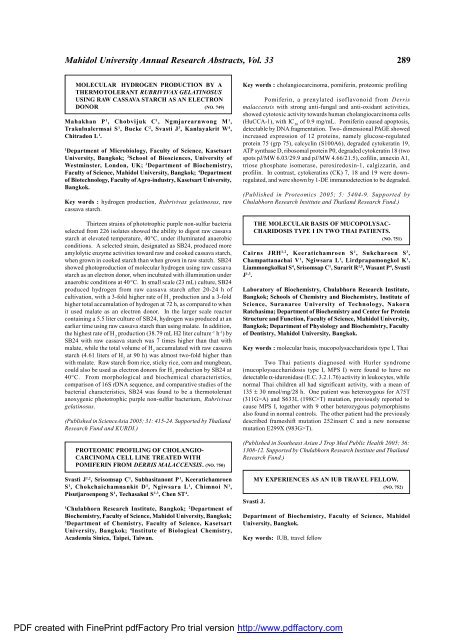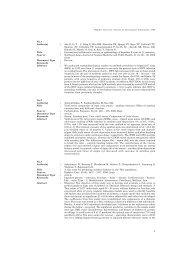Faculty of Science - Mahidol University
Faculty of Science - Mahidol University
Faculty of Science - Mahidol University
Create successful ePaper yourself
Turn your PDF publications into a flip-book with our unique Google optimized e-Paper software.
<strong>Mahidol</strong> <strong>University</strong> Annual Research Abstracts, Vol. 33 289<br />
MOLECULAR HYDROGEN PRODUCTION BY A<br />
THERMOTOLERANT RUBRIVIVAX GELATINOSUS<br />
USING RAW CASSAVA STARCH AS AN ELECTRON<br />
DONOR (NO. 749)<br />
Mahakhan P 1 , Chobvijuk C 1 , Ngmjarearnwong M 1 ,<br />
Trakulnalermsai S 1 , Bucke C 2 , Svasti J 3 , Kanlayakrit W 4 ,<br />
Chitradon L 1 .<br />
1 Department <strong>of</strong> Microbiology, <strong>Faculty</strong> <strong>of</strong> <strong>Science</strong>, Kasetsart<br />
<strong>University</strong>, Bangkok; 2 School <strong>of</strong> Biosciences, <strong>University</strong> <strong>of</strong><br />
Westminster, London, UK; 3 Department <strong>of</strong> Biochemistry,<br />
<strong>Faculty</strong> <strong>of</strong> <strong>Science</strong>, <strong>Mahidol</strong> <strong>University</strong>, Bangkok; 4 Department<br />
<strong>of</strong> Biotechnology, <strong>Faculty</strong> <strong>of</strong> Agro-industry, Kasetsart <strong>University</strong>,<br />
Bangkok.<br />
Key words : hydrogen production, Rubrivivax gelatinosus, raw<br />
cassava starch.<br />
Thirteen strains <strong>of</strong> phototrophic purple non-sulfur bacteria<br />
selected from 226 isolates showed the ability to digest raw cassava<br />
starch at elevated temperature, 40°C, under illuminated anaerobic<br />
conditions. A selected strain, designated as SB24, produced more<br />
amylolytic enzyme activities toward raw and cooked cassava starch,<br />
when grown in cooked starch than when grown in raw starch. SB24<br />
showed photoproduction <strong>of</strong> molecular hydrogen using raw cassava<br />
starch as an electron donor, when incubated with illumination under<br />
anaerobic conditions at 40°C. In small scale (23 mL) culture, SB24<br />
produced hydrogen from raw cassava starch after 20-24 h <strong>of</strong><br />
cultivation, with a 3-fold higher rate <strong>of</strong> H 2 production and a 3-fold<br />
higher total accumulation <strong>of</strong> hydrogen at 72 h, as compared to when<br />
it used malate as an electron donor. In the larger scale reactor<br />
containing a 5.5 liter culture <strong>of</strong> SB24, hydrogen was produced at an<br />
earlier time using raw cassava starch than using malate. In addition,<br />
the highest rate <strong>of</strong> H 2 production (38.79 mL H2 liter culture -1 h -1 ) by<br />
SB24 with raw cassava starch was 7 times higher than that with<br />
malate, while the total volume <strong>of</strong> H 2 accumulated with raw cassava<br />
starch (4.61 liters <strong>of</strong> H 2 at 90 h) was almost two-fold higher than<br />
with malate. Raw starch from rice, sticky rice, corn and mungbean,<br />
could also be used as electron donors for H 2 production by SB24 at<br />
40°C. From morphological and biochemical characteristics,<br />
comparison <strong>of</strong> 16S rDNA sequence, and comparative studies <strong>of</strong> the<br />
bacterial characteristics, SB24 was found to be a thermotolerant<br />
anoxygenic phototrophic purple non-sulfur bacterium, Rubrivivax<br />
gelatinosus.<br />
(Published in <strong>Science</strong>Asia 2005; 31: 415-24. Supported by Thailand<br />
Research Fund and KURDI.)<br />
PROTEOMIC PROFILING OF CHOLANGIO-<br />
CARCINOMA CELL LINE TREATED WITH<br />
POMIFERIN FROM DERRIS MALACCENSIS. (NO. 750)<br />
Svasti J 1,2 , Srisomsap C 1 , Subhasitanont P 1 , Keeratichamroen<br />
S 1 , Chokchaichamnankit D 1 , Ngiwsara L 1 , Chimnoi N 1 ,<br />
Pisutjaroenpong S 1 , Techasakul S 1,3 , Chen ST 4 .<br />
1 Chulabhorn Research Institute, Bangkok; 2 Department <strong>of</strong><br />
Biochemistry, <strong>Faculty</strong> <strong>of</strong> <strong>Science</strong>, <strong>Mahidol</strong> <strong>University</strong>, Bangkok;<br />
3 Department <strong>of</strong> Chemistry, <strong>Faculty</strong> <strong>of</strong> <strong>Science</strong>, Kasetsart<br />
<strong>University</strong>, Bangkok; 4 Institute <strong>of</strong> Biological Chemistry,<br />
Academia Sinica, Taipei, Taiwan.<br />
Key words : cholangiocarcinoma, pomiferin, proteomic pr<strong>of</strong>iling<br />
Pomiferin, a prenylated is<strong>of</strong>lavonoid from Derris<br />
malaccensis with strong anti-fungal and anti-oxidant activities,<br />
showed cytotoxic activity towards human cholangiocarcinoma cells<br />
(HuCCA-1), with IC 50 <strong>of</strong> 0.9 mg/mL. Pomiferin caused apoptosis,<br />
detectable by DNA fragmentation. Two- dimensional PAGE showed<br />
increased expression <strong>of</strong> 12 proteins, namely glucose-regulated<br />
protein 75 (grp 75), calcyclin (S100A6), degraded cytokeratin 19,<br />
ATP synthase D, ribosomal protein P0, degraded cytokeratin 18 (two<br />
spots pI/MW 6.03/29.9 and pI/MW 4.66/21.5), c<strong>of</strong>ilin, annexin A1,<br />
triose phosphate isomerase, peroxiredoxin-1, calgizzarin, and<br />
pr<strong>of</strong>ilin. In contrast, cytokeratins (CK) 7, 18 and 19 were downregulated,<br />
and were shown by 1-DE immunodetection to be degraded.<br />
(Published in Proteomics 2005; 5: 5404-9. Supported by<br />
Chulabhorn Research Institute and Thailand Research Fund.)<br />
THE MOLECULAR BASIS OF MUCOPOLYSAC-<br />
CHARIDOSIS TYPE I IN TWO THAI PATIENTS.<br />
(NO. 751)<br />
Cairns JRH 1,2 , Keeratichamroen S 1 , Sukcharoen S 3 ,<br />
Champattanachai V 1 , Ngiwsara L 1 , Lirdprapamongkol K 1 ,<br />
Liammongkolkul S 4 , Srisomsap C 1 , Surarit R 1,5 , Wasant P 4 , Svasti<br />
J 1,3 .<br />
Laboratory <strong>of</strong> Biochemistry, Chulabhorn Research Institute,<br />
Bangkok; Schools <strong>of</strong> Chemistry and Biochemistry, Institute <strong>of</strong><br />
<strong>Science</strong>, Suranaree <strong>University</strong> <strong>of</strong> Technology, Nakorn<br />
Ratchasima; Department <strong>of</strong> Biochemistry and Center for Protein<br />
Structure and Function, <strong>Faculty</strong> <strong>of</strong> <strong>Science</strong>, <strong>Mahidol</strong> <strong>University</strong>,<br />
Bangkok; Department <strong>of</strong> Physiology and Biochemistry, <strong>Faculty</strong><br />
<strong>of</strong> Dentistry, <strong>Mahidol</strong> <strong>University</strong>, Bangkok.<br />
Key words : molecular basis, mucopolysaccharidosis type I, Thai<br />
Two Thai patients diagnosed with Hurler syndrome<br />
(mucoploysaccharidosis type I, MPS I) were found to have no<br />
detectable α-iduronidase (E.C. 3.2.1.76) activity in leukocytes, while<br />
normal Thai children all had significant activity, with a mean <strong>of</strong><br />
135 ± 30 nmol/mg/28 h. One patient was heterozygous for A75T<br />
(311G>A) and S633L (198C>T) mutation, previously reported to<br />
cause MPS I, together with 9 other heterozygous polymorphisms<br />
also found in normal controls. The other patient had the previously<br />
described frameshift mutation 252insert C and a new nonsense<br />
mutation E299X (983G>T).<br />
(Published in Southeast Asian J Trop Med Public Health 2005; 36:<br />
1308-12. Supported by Chulabhorn Research Institute and Thailand<br />
Research Fund.)<br />
MY EXPERIENCES AS AN IUB TRAVEL FELLOW.<br />
Svasti J.<br />
(NO. 752)<br />
Department <strong>of</strong> Biochemistry, <strong>Faculty</strong> <strong>of</strong> <strong>Science</strong>, <strong>Mahidol</strong><br />
<strong>University</strong>, Bangkok.<br />
Key words: IUB, travel fellow<br />
PDF created with FinePrint pdfFactory Pro trial version http://www.pdffactory.com
















